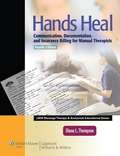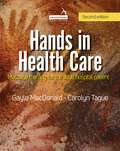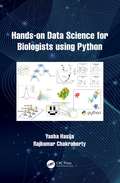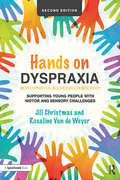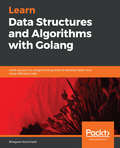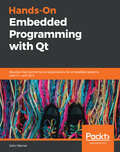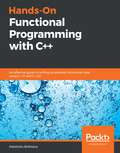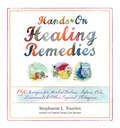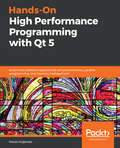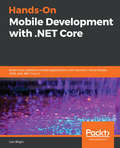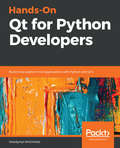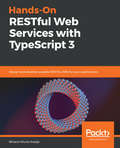- Table View
- List View
Handbuch für Vibrationstraining und Vibrationstherapie
by Jörn RittwegerDieses Buch behandelt die praktischen Aspekte von Vibrationstraining und Vibrationstherapie. Darüber hinaus werden die technischen und physiologischen Hintergründe beschrieben, um angewandten Wissenschaftlern und Ärzten ein tieferes Verständnis für das therapeutische Potenzial des Vibrationstrainings zu vermitteln. Seit ihrem Aufkommen vor zwei Jahrzehnten hat sich das Vibrationstraining zu einer weit verbreiteten Form der körperlichen Ertüchtigung entwickelt, die in allen Bereichen der Rehabilitation eingesetzt wird. Das Ziel dieses Buches ist es, die Lücke zwischen wissenschaftlichen Erkenntnissen und der Praxis zu schließen.Da die berufsbedingte Vibrationsexposition zu den bekannten ungünstigen Auswirkungen führt, widmet sich das Buch auch den potenziellen Risiken, Gefahren und Kontraindikationen, und natürlich wird die Anwendung der Vibrationstherapie bei einer Reihe spezifischer Erkrankungen in klinisch verwertbarer Form dargestellt. Aufgrund seines Umfangs ist dieses Buch für Physiotherapeuten und Sportwissenschaftler, aber auch für ein breiteres Spektrum von Ärzten, die auf dem Gebiet der Rehabilitation tätig sind, von Interesse.
Handbuch zur Untersuchung der Lendenwirbelsäule und der unteren Extremitäten: Ein praktischer Leitfaden
by Roger PillemerNeben ergänzenden radiologischen Bildgebungen ist die körperliche Untersuchung ein wesentliches diagnostisches Element für den Orthopäden. Daher ist es für Medizinstudenten, Assistenzärzte und Praktikanten in der Orthopädie von größter Bedeutung, diese Untersuchungen gründlich zu erlernen, sowohl während der Ausbildung als auch in der späteren Praxis. Dieser praktische Text stellt prägnant alle notwendigen Informationen rund um die körperliche Untersuchung der unteren Extremität und der Lendenwirbelsäule dar. Die untere Wirbelsäule, Hüfte, Knie und Fuß sowie Sprunggelenk werden in eigenen thematischen Abschnitten besprochen, wobei jeder Abschnitt aus drei Hauptkapiteln besteht. Das erste Kapitel beschreibt die muskuloskelettale Anatomie und Funktion des Gelenks und erläutert die Tests sowie die Begründung für ihre Durchführung. Das zweite Kapitel stellt die systematischen Untersuchungen vor, die in jedem Fall durchgeführt werden, und das dritte Kapitel beschreibt Gelenksuntersuchungen bei spezifischen Erkrankungen , einschließlich Tendinopathien, Arthrose, neurologische Störungen, Deformitäten und mehr. Zahlreiche Aufzählungen und Farbbilder im Text beschreiben und illustrieren jeden Test und jedes körperliche Zeichen. Praktisch und benutzerfreundlich ist das "Handbuch der Lendenwirbelsäulen- und Unterschenkeluntersuchung" ein wertvoller Leitfaden für dieses wichtige diagnostische Werkzeug für Studenten und Praktiker gleichermaßen.
Handeln bei Verdacht auf Kindeswohlgefährdung: Leitfaden für Ergotherapie, Logopädie und Physiotherapie (essentials)
by Marius WagnerDas essential behandelt den Umgang mit Hinweisen auf Kindeswohlgefährdung in Praxen von Ergotherapie, Logopädie und Physiotherapie. Besonderes Augenmerk wird dabei auf den Rechtsanspruch auf eine externe Beratung und die Möglichkeiten ihrer Inanspruchnahme gelegt. Die Beschreibung von Formen der Kindeswohlgefährdung und der möglichen Anzeichen, die in der Arbeit mit Kindern und Jugendlichen zu beobachten sind, ermöglicht es, Kindeswohlgefährdung zu erkennen. Eine Auflistung der notwendigen Handlungsschritte mit Tipps für die Praxis führt sicher durch das vorgeschriebene Verfahren.
Handle with Care: the gripping emotional drama by the number one bestselling author of A Spark of Light
by Jodi PicoultTHE NUMBER ONE SUNDAY TIMES BESTSELLER'Superb, many-stranded and grimly topical' The TimesFive years ago, Charlotte O'Keefe had everything she could want: a loving husband, a wonderful daughter and another child on the way.But when Willow was born with brittle bone disease, this perfect life shattered before her eyes. Now, as the years have gone by and the costs to care for Willow have mounted up, the family has begun to falter and the pressure of caring for their sick child.In Charlotte's eyes, only one person could have stopped this from happening: Piper, her obstetrician and best friend, who didn't advise Charlotte that she might want to terminate the pregnancy. Now, as she stands in court, she must defend the unthinkable.That she would have chosen for her daughter not to be born. 'You won't sleep until you find out what happens' HeatTHE BOOK OF TWO WAYS, Jodi's stunning new novel about life, death and missed opportunities is available to pre-order now.
Handleiding groepsschematherapie voor cluster C-persoonlijkheidsstoornissen
by Eelco H. Muste Edith E.M.L. TjoaDit boek biedt behandelaren in de ggz een behandelprotocol voor schematherapie bij cluster C-persoonlijkheidsproblematiek. Het protocol is ontwikkeld voor groepsschematherapie, maar is ook toepasbaar voor individuele therapie. Daarnaast is het goed toepasbaar bij chronische problematiek. Cluster C-persoonlijkheidsstoornissen komen frequent voor, bij 3 tot 9 % van de algemene bevolking. Bij ongeveer de helft van de stemmings-, angst- en eetstoornissen is er ook sprake van comorbide cluster C-problematiek. In Handleiding groepsschematherapie voor cluster C-persoonlijkheidsstoornissen wordt de behandeling helder beschreven. Het laat duidelijk de structuur en de focus van de sessies zien en welke oefeningen hierbij gebruikt kunnen worden. Gewerkt wordt met het modusmodel van schematherapie; een heel herkenbaar model voor cliënten, dat de behandeling snel concreet maakt.De in dit boek beschreven behandelvorm met dertig sessies is wetenschappelijk onderzocht met een pilotonderzoek in verschillende instellingen in Nederland. Hierbij is aangetoond dat er een zeer lage drop-out is en dat therapeuten en cliënten enthousiast zijn over de vorm van de behandelsessies. De eerste resultaten m.b.t. de persoonlijkheidsproblematiek tonen een positieve trend. Dit ondanks de vaak hardnekkige problematiek, die klachten als angststoornissen, eetstoornissen en depressies in stand houdt.Groepsschematherapie voor cluster C-persoonlijkheidsstoornissen bestaat uit een handleiding voor de therapeut en een werkboek voor de cliënt. Tegen het einde van de behandeling wordt de cliënt steeds meer zijn eigen therapeut en bepaalt hij zelf welk huiswerk in de laatste fase passend is.“Ik was bij de start echt wat sceptisch over de lengte van de therapie en vroeg me af of we het wel gingen redden met alle wisselingen in de groep. Ik was dan ook positief verrast over wat het voor cliënten kon betekenen. Het vraagt enige inzet en draagkracht van de cliënt, maar het is verrassend wat deze ervaringsgerichte therapie kan doen en betekenen voor cliënten met (soms complexe) vermijdende persoonlijkheidsproblematiek."Berdien Henniphof, GZ-psycholoog, De Viersprong
Handleiding medisch wetenschappelijk onderzoek
by G. A. Zielhuis P.H.J.M. Heydendael J. C. Maltha P.L.C.M. RielDe moderne geneeskunde is in belangrijke mate gefundeerd op resultaten van medisch-wetenschappelijk onderzoek. Nieuwe inzichten in preventie, diagnose en prognose van ziekten kunnen alleen tot stand komen door degelijk uitgevoerd wetenschappelijk onderzoek. Evenzo kan de effectiviteit van een behandeling alleen door middel van goed onderzoek worden geëvalueerd. Kortom, medisch-wetenschappelijk onderzoek onderbouwt de toepassing van geneeskunde. Op basis van een 12-stappenplan biedt de Handleiding medisch-wetenschappelijk onderzoek de lezer een praktische handreiking bij de opzet en uitvoering van onderzoek. Een uitstekend hulpmiddel voor de: -arts(-assistent) die een wetenschappelijk artikel wil publiceren; -junior onderzoeker bij de aanvang van een onderzoek; -student die een scriptie of wetenschappelijk verslag wil schrijven; Deze achtste druk is geheel geactualiseerd. Er ligt nu meer nadruk op de context waarin het onderzoek plaatsvindt: wat is de relevantie voor mens en maatschappij, welke belangen zijn er, en hoe kan onderzoek integer en transparant blijven. Het aantal vormen van onderzoek is uitgebreid, o. a. met chirurgisch onderzoek, laboratoriumexperimenten, Big Data en data-gedreven studies. Actuele ontwikkelingen op het gebied van wetenschappelijke informatievoorziening, open access, organisatie en financiering en wetenschappelijke toetsing zijn verwerkt. Met moderne voorbeelden wordt ook de laboratoriumonderzoeker aangesproken. Het volledige boek is ook digitaal beschikbaar met samenvattingen en toetsvragen per hoofdstuk en interessante en verdiepende links.
Handling Death and Bereavement at Work
by David Charles-EdwardsAn estimated 3,500 people die every day in the UK. If someone at work or their partner or close family member dies, managers and colleagues need to respond appropriately. This book breaks new ground in placing bereavement on the management agenda. It addresses some challenging questions such as: What to say and what not to say? How to balance the needs of the person and the job? How do you get it right in a diverse, multi-cultural workforce? How do you decide what time off is reasonable? How can other people at work help, as well as avoiding making the situation worse? This book is an essential guide for anyone in an organisation who has to take responsibility in the event of death. It covers issues such as what do in the event of a sudden death at work, managing staff who are terminally ill, and practical help after death including funerals. It is a unique and constant point of reference for anyone concerned with one of the most challenging issues to be faced in the workplace.
Handling of Radiation Accident Patients: by Paramedical and Hospital Personnel Second Edition
by Thomas A. CarderThis book provides guidelines, procedures, and techniques for emergency support personnel involved with handling radiation accident patients. Prepared by a former emergency medical responder, this book amplifies the level of radiological response training provided to emergency medical technicians and emergency room physicians and nurses. Supporting graphics, references, and a glossary help readers understand the critical aspects of emergency trauma treatment.
Handreading: A STUDY OF CHARACTER AND PERSONALITY
by Laffan, M NFirst Published in 1999. Routledge is an imprint of Taylor & Francis, an informa company.
Handrehabilitation: Für Ergotherapeuten und Physiotherapeuten, Band 3: Manuelle Therapie, Physikalische Maßnahmen, Schienen (Rehabilitation Und Prävention Ser. #37)
by Birgitta Waldner-NilssonDas Standardwerk für Therapeuten behandelt Erkrankungen und Verletzungen der Hände. Für die 2. Auflage wurden die Inhalte komplett überarbeitet, aktualisiert und erweitert, so dass das Werk nun drei Bände umfasst. In Band 3 behandelt die Autorin die Themen manuelle Therapie, physikalische Maßnahmen sowie Schienen. Sie hat u. a. Abschnitte zu physiotherapeutischen Therapieansätzen inklusive detaillierter Anleitungen (funktioneller Befund, manuelle Therapie, Arm-Schulterbehandlung, Überlastungssyndrome) ergänzt.
Hands Heal: Communication, Documentation, and Insurance Billing For Manual Therapists
by Diana L. ThompsonHands Heal provides valuable guidance on taking client histories, setting functional goals, communicating with other health care and legal professionals, documenting outcomes, and billing insurance companies. This comprehensive resource for massage therapy students and practitioners also includes information on HIPAA, information on relevant CPT and ICD-9 codes, and offers a variety of sample forms that can be used in practice.
Hands Heal: Communication, Documentation, and Insurance Billing for Manual Therapists (Lww Massage Therapy And Bodywork Educational Ser.)
by Diana ThompsonPublisher's Note: Products purchased from 3rd Party sellers are not guaranteed by the Publisher for quality, authenticity, or access to any online entitlements included with the product. This 5th Edition of Hands Heal offers massage therapy students comprehensive coverage of communication, assessment, and electronic and paper documentation skills, from taking client histories and setting functional goals to documenting treatment outcomes. Reflecting the latest changes in the curriculum and the profession, the book is more ELAP compliant, includes changes to ICD-10 and CPT codes, and updates to HIPAA regulations. The new edition incorporates the effect of the Affordable Care Act on manual therapists and offers increased emphasis on communication with doctors and other healthcare providers. Integrated electronic charting (EHR) coverage, new case studies and new case study types, and compelling new online videos help students master course concepts and prepare for practice.
Hands Heal: Communication, Documentation, and Insurance Billing for Manual Therapists, Second Edition.
by Diana L. Thompson"Hands Heal" is an excellent tool for gaining knowledge about comprehensive communcation and documentation competence. This book provides information on how to take client histories, set functional goals, successfully bill insurance companies, document outcomes for insurance purposes, and more.
Hands in Health Care: Massage therapy for the adult hospital patient
by Gayle MacDonald Carolyn TagueThis is the second edition of a highly successful book - the only one available on this topic. The first edition was written by a well-known massage therapist and author, Gayle MacDonald. For the second edition Gayle has brought in a co-author, Carolyn Tague. Both are well-known and highly respected in the field of hospital massage therapy.The second edition focuses solely on the adult patient and has new chapters on aromatherapy massage, end-of-life care, cultural sensitivity and understanding the therapeutic relationship between patient and practitioner. It also incorporates new sections on addiction and neurological disorders, as well as the most recent research from around the world. The new edition is highly illustrated with full color photographs and drawings, including many new illustrations.
Hands on Data Science for Biologists Using Python
by Yasha Hasija Rajkumar ChakrabortyHands-on Data Science for Biologists using Python has been conceptualized to address the massive data handling needs of modern-day biologists. With the advent of high throughput technologies and consequent availability of omics data, biological science has become a data-intensive field. This hands-on textbook has been written with the inception of easing data analysis by providing an interactive, problem-based instructional approach in Python programming language. The book starts with an introduction to Python and steadily delves into scrupulous techniques of data handling, preprocessing, and visualization. The book concludes with machine learning algorithms and their applications in biological data science. Each topic has an intuitive explanation of concepts and is accompanied with biological examples. Features of this book: The book contains standard templates for data analysis using Python, suitable for beginners as well as advanced learners. This book shows working implementations of data handling and machine learning algorithms using real-life biological datasets and problems, such as gene expression analysis; disease prediction; image recognition; SNP association with phenotypes and diseases. Considering the importance of visualization for data interpretation, especially in biological systems, there is a dedicated chapter for the ease of data visualization and plotting. Every chapter is designed to be interactive and is accompanied with Jupyter notebook to prompt readers to practice in their local systems. Other avant-garde component of the book is the inclusion of a machine learning project, wherein various machine learning algorithms are applied for the identification of genes associated with age-related disorders. A systematic understanding of data analysis steps has always been an important element for biological research. This book is a readily accessible resource that can be used as a handbook for data analysis, as well as a platter of standard code templates for building models.
Hands on Dyspraxia: Supporting Young People with Motor and Sensory Challenges
by Jill Christmas Rosaline Van de WeyerThis updated new edition is a practical guidebook for parents, teachers and other professionals supporting children with sensory and motor learning difficulties. It offers an understanding of developmental coordination disorder (DCD), and the impact that this can have in both home and school settings. Each chapter offers practical ‘hands-on’ strategies, activities and ideas for managing the effects of the condition as well as providing a sound medical and physiological understanding of the condition to facilitate access to education and everyday living. Each chapter contains: A clear explanation of potential challenges that people with DCD and coexisting conditions face, with an introductory definition, along with reference to current terminology Exploration of the implications of these challenges on home life, educational and social environments Practical strategies and ideas to help the child or young person reach their full potential Written by occupational therapists with extensive experience of DCD/dyspraxia and possible associated conditions, this book is structured in an accessible way, suitable for: parents, carers, teachers or health professionals seeking guidance for the young people they support. This is a must read for anybody looking to support children and young people with this often misunderstood condition.
Hands-On Data Structures and Algorithms with Go: Level Up Your Go Programming Skills To Develop Faster And More Efficient Code
by Bhagvan KommadiThis comprehensive book is for developers who want to understand how to select the best data structures and algorithms that will help to solve specific problems. Basic Go programming knowledge would be an added advantage.
Hands-On Deep Learning Algorithms with Python: Master deep learning algorithms with extensive math by implementing them using TensorFlow
by Sudharsan RavichandiranUnderstand basic to advanced deep learning algorithms, the mathematical principles behind them, and their practical applications. Key Features Get up-to-speed with building your own neural networks from scratch Gain insights into the mathematical principles behind deep learning algorithms Implement popular deep learning algorithms such as CNNs, RNNs, and more using TensorFlow Book Description Deep learning is one of the most popular domains in the AI space, allowing you to develop multi-layered models of varying complexities. This book introduces you to popular deep learning algorithms—from basic to advanced—and shows you how to implement them from scratch using TensorFlow. Throughout the book, you will gain insights into each algorithm, the mathematical principles behind it, and how to implement it in the best possible manner. The book starts by explaining how you can build your own neural networks, followed by introducing you to TensorFlow, the powerful Python-based library for machine learning and deep learning. Moving on, you will get up to speed with gradient descent variants, such as NAG, AMSGrad, AdaDelta, Adam, and Nadam. The book will then provide you with insights into RNNs and LSTM and how to generate song lyrics with RNN. Next, you will master the math for convolutional and capsule networks, widely used for image recognition tasks. Then you learn how machines understand the semantics of words and documents using CBOW, skip-gram, and PV-DM. Afterward, you will explore various GANs, including InfoGAN and LSGAN, and autoencoders, such as contractive autoencoders and VAE. By the end of this book, you will be equipped with all the skills you need to implement deep learning in your own projects. What you will learn Implement basic-to-advanced deep learning algorithms Master the mathematics behind deep learning algorithms Become familiar with gradient descent and its variants, such as AMSGrad, AdaDelta, Adam, and Nadam Implement recurrent networks, such as RNN, LSTM, GRU, and seq2seq models Understand how machines interpret images using CNN and capsule networks Implement different types of generative adversarial network, such as CGAN, CycleGAN, and StackGAN Explore various types of autoencoder, such as Sparse autoencoders, DAE, CAE, and VAE Who this book is for If you are a machine learning engineer, data scientist, AI developer, or simply want to focus on neural networks and deep learning, this book is for you. Those who are completely new to deep learning, but have some experience in machine learning and Python programming, will also find the book very helpful.
Hands-On Embedded Programming with Qt: Develop high performance applications for embedded systems with C++ and Qt 5
by John WernerA comprehensive guide that will get you up and running with embedded software development using Qt5 Key Features Learn to create fluid, cross-platform applications for embedded devices Achieve optimum performance in your applications with QT Lite project Explore the implementation of Qt with IoT using QtMqtt, QtKNX, and QtWebSockets Book Description Qt is an open-source toolkit suitable for cross-platform and embedded application development. This book uses inductive teaching to help you learn how to create applications for embedded and Internet of Things (IoT) devices with Qt 5. You'll start by learning to develop your very first application with Qt. Next, you'll build on the first application by understanding new concepts through hands-on projects and written text. Each project will introduce new features that will help you transform your basic first project into a connected IoT application running on embedded hardware. In addition to practical experience in developing an embedded Qt project, you will also gain valuable insights into best practices for Qt development, along with exploring advanced techniques for testing, debugging, and monitoring the performance of Qt applications. Through the course of the book, the examples and projects are demonstrated in a way so that they can be run both locally and on an embedded platform. By the end of this book, you will have the skills you need to use Qt 5 to confidently develop modern embedded applications. What you will learn Understand how to develop Qt applications using Qt Creator under Linux Explore various Qt GUI technologies to build resourceful and interactive applications Understand Qt's threading model to maintain a responsive UI Get to grips with remote target load and debug under Qt Creator Become adept at writing IoT code using Qt Learn a variety of software best practices to ensure that your code is efficient Who this book is for This book is for software and hardware professionals with experience in different domains who are seeking new career opportunities in embedded systems and IoT. Working knowledge of the C++ Linux command line will be useful to get the most out of this book.
Hands-On Functional Programming with C++: An effective guide to writing accelerated functional code using C++17 and C++20
by Alexandru Bolboaca<p>Learn functional programming and build robust applications using the latest functional features in C++ <p>Key Features: <p> <li>Learn programming concepts such as loops, expressive code, and simple parallelization <li>Understand the working of Lambdas and Currying and write Pure functions <li>Explore event sourcing and other functional patterns to improve the efficiency of your applications</li> <p>Functional programming enables you to divide your software into smaller, reusable components that are easy to write, debug, and maintain. Combined with the power of C++, you can develop scalable and functional applications for modern software requirements. This book will help you discover the functional features in C++ 17 and C++ 20 to build enterprise-level applications. <p>Starting with the fundamental building blocks of functional programming and how to use them in C++, you'll explore functions, currying, and lambdas. As you advance, you'll learn how to improve cohesion and delve into test-driven development, which will enable you in designing better software. In addition to this, the book covers architectural patterns such as event sourcing to help you get to grips with the importance of immutability for data storage. You'll even understand how to “think in functions” and implement design patterns in a functional way. <p>By the end of this book, you'll be able to write faster and cleaner production code in C++ with the help of functional programming. <p>What you will learn: <p> <li>Understand the fundamentals of functional programming <li>Structure your code by understanding the building blocks of functional programming <li>Compare design styles in functional programming and object-oriented programming (OOP) <li>Use the concept of currying to create new functions in C++ <li>Become skilled at implementing design patterns in a functional way <li>Get to grips with multithreading by means of functional programming <li>Learn how to improve memory consumption when using functional constructs </li> <p>Who this book is for: This book is for C++ developers who want to learn functional programming but have little to no knowledge of the paradigm. Although no prior knowledge of functional programming is necessary, basic C++ programming experience will help you understand key concepts covered in the book.</p>
Hands-On Healing Remedies: 150 Recipes for Herbal Balms, Salves, Oils, Liniments & Other Topical Therapies
by Stephanie L. TourlesKeep your family healthy and chemical free by making your own natural remedies. Stephanie Tourles offers 150 original recipes for herbal balms, oils, salves, liniments, and other topical ointments to treat a wide range of conditions. This comprehensive guide is filled with safe and effective cures for scores of common ailments, including headaches, backaches, arthritis, insomnia, splinters, and more. Take control of your well-being and stock your family’s medicine cabinet with gentle, all-natural homemade healing formulations.
Hands-On High performance with QT: Build cross-platform applications using concurrency, parallel programming, and memory management
by Marek KrajewskiThis book for Qt developers who wish to build highly performant applications for desktop and embedded devices, and have C++ knowledge.
Hands-On Mobile Development with .NET Core: Build cross-platform mobile applications with Xamarin, Visual Studio 2019, and .NET Core 3
by Can BilginDevelop native applications for multiple mobile and desktop platforms including but not limited to iOS, Android, and UWP with the Xamarin framework and Xamarin.FormsKey FeaturesUnderstand .NET Core and its cross-platform development philosophy Build Android, iOS, and Windows mobile applications with C#, .NET Core, and Azure Cloud ServicesBring Artificial Intelligence capabilities into your mobile applications with Azure AIBook Description.NET Core is the general umbrella term used for Microsoft’s cross-platform toolset. Xamarin used for developing mobile applications, is one of the app model implementations for .NET Core infrastructure. In this book, you will learn how to design, architect, and develop highly attractive, maintainable, efficient, and robust mobile applications for multiple platforms, including iOS, Android, and UWP, with the toolset provided by Microsoft using Xamarin, .NET Core, and Azure Cloud Services. This book will take you through various phases of application development with Xamarin, from environment setup, design, and architecture to publishing, using real-world scenarios. Throughout the book, you will learn how to develop mobile apps using Xamarin, Xamarin.Forms and .NET Standard; implement a webbased backend composed of microservices with .NET Core using various Azure services including but not limited to Azure App Services, Azure Active Directory, Notification Hub, Logic Apps, and Azure Functions, Cognitive Services; create data stores using popular database technologies such as Cosmos DB, SQL and Realm.Towards the end, the book will help developers to set up an efficient and maintainable development pipeline to manage the application life cycle using Visual Studio App Center and Visual Studio Services.What you will learnImplement native applications for multiple mobile and desktop platformsUnderstand and use various Azure Services with .NET CoreMake use of architectural patterns designed for mobile and web applicationsUnderstand the basic Cosmos DB conceptsUnderstand how different app models can be used to create an app serviceExplore the Xamarin and Xamarin.Forms UI suite with .NET Core for building mobile applicationsWho this book is forThis book is for mobile developers who wish to develop cross-platform mobile applications. Programming experience with C# is required. Some knowledge and understanding of core elements and cross-platform application development with .NET is required.
Hands-On Qt for Python Developers: Build cross-platform GUI applications with Python and Qt 5
by Volodymyr KirichinetsBoost UI development with ready-made widgets, controls, charts, and data visualization and create stunning 2D and 3D graphics with PyQt and PySide2.Key FeaturesBuild optimized GUI applications by implementing multiprocessing and concurrencyUnderstand embedded and mobile development with PyQt and PySideLearn to create magnificent GUI applications using Pyside2 and QtQuick/QMLBook DescriptionQt is one of the most widely used and flexible frameworks for GUI application development, allowing you to write your application once and then deploy it to multiple operating systems. This book combines the best of Python and Qt to help you develop GUI applications with Python bindings, such as PyQt and PySide, that will supercharge your Python applications.The book begins with an overview of Qt and QML. You’ll start by working with PyQt GUI elements to style your applications. Then, you will learn how to use QWidget, frames, labels, and text fields, and work with graphics. This will be followed by taking you through how elements in the application communicate with each other by understanding signals, slots, and event handlers. This book will help you to gain a better understanding of the Qt framework and the tools to resolve issues when testing, linking, debugging, and multithreading your Python GUI applications. Finally, the book will help you get to grips with embedded and mobile development using PyQt and PySide.By the end of the book, you will be able to create modern, responsive, cross-platform desktop applications with the power of Qt, Python, and QML.What you will learnExplore PyQt5 and PySide2 to create comprehensive GUI applicationsFind out how threading and multiprocessing workUnderstand how to style GUIs with PyQtGet to grips with implementing buttonsUnderstand how elements communicate with signals, slots, and event handlersExplore mobile development with PyQt and PySideWho this book is forThis book is for Python developers who want to develop GUIs and cross-platform applications that are modern, responsive, and attractive. No prior knowledge of Qt or QML is required.
Hands-On RESTful Web Services with TypeScript 3: Design and develop scalable RESTful APIs for your applications
by Biharck AraújoThe book is aimed at web developers who have a basic understanding of the REST concepts and want to familiarize themselves with the idea of designing and developing RESTful APIs.
